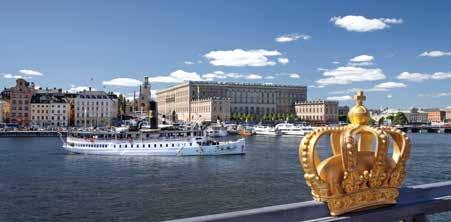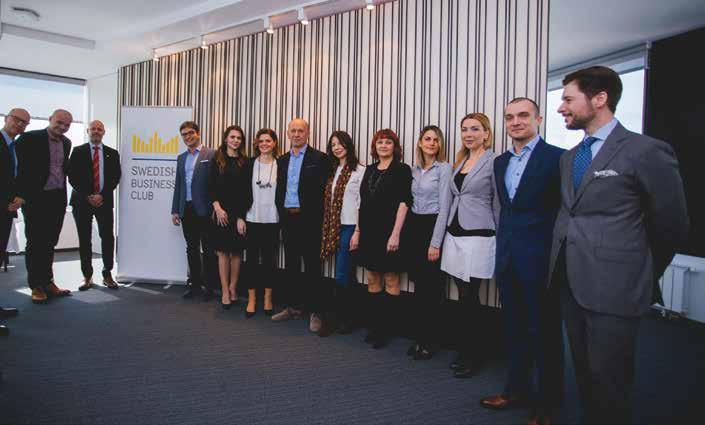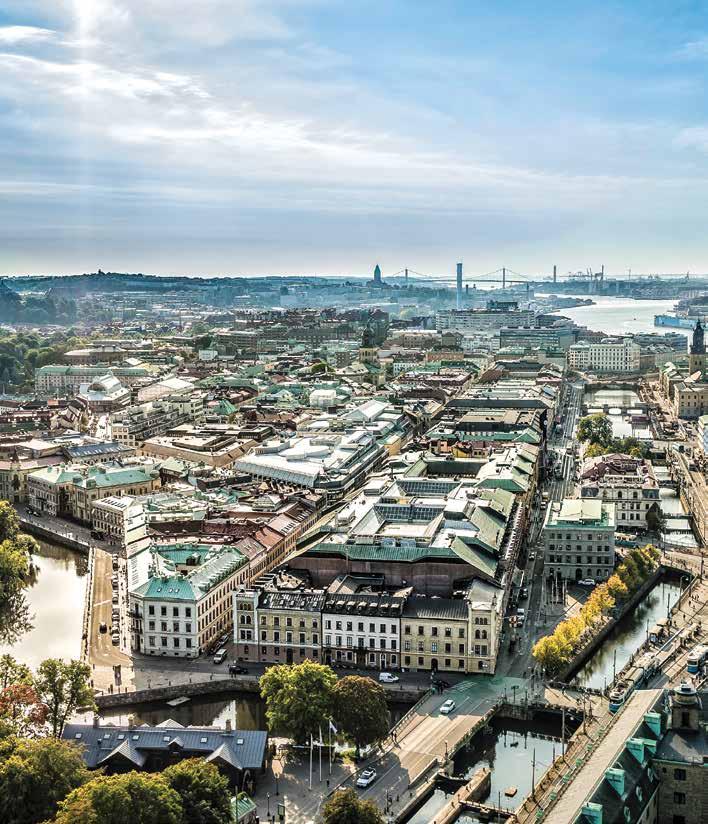
8 minute read
ABILITY TO CHANGE AND ADAPT
ECONOMY
ABILITY TO CHANGE AND ADAPT
Advertisement
Sweden has gone through tremendous changes over the last one and a half century, from being a rela tively poor agrarian country with natural resources limited to timber and iron ore to being one of the most prosper ous modern economies in the world. Along the way Sweden registered an almost un precedented growth rate that coupled with stability, which was propped up by neutral ity and the consensus system of labor relations between workers and employers, catapulted it to becoming a globally compet itive country at the forefront of innovation.
However, rather than discovering a uni versal formula for success, Swedish economy was able to evolve the formula, thus suc ceeding despite a number of changing conditions and challenges that its economy encountered over time. So, in a way, the secret to its success is Sweden’s ability to constantly change with times and adapt to overcome the emerging hurdles. From the development of the “Swedish model” in the 1930’s as a compromise between social democratic ruled state and the private sector, to the privatization towards the end of the last century, and the banking crisis of the 1990’s, Sweden has shown the capacity for quick turn-arounds to cope with newly emerging situations.
Another element of Sweden’s success is the liberalization and openness of its economy. Being small in terms of popu lation, with only 10 million people today, Sweden has long realized that it cannot base its prosperity on the strength of its domes tic market alone. It had to keep a wider perspective to fully develop its potential. Also, the liberalization of the Swedish economy began early, during the free-trade era in the second half of the 19th century, when
SCIENCE PARKS: THERE ARE MORE THAN 30 , WITH OVER 5,000 COMPANIES, EMPLOYING 70,000 PEOPLE
Sweden benefited from the growing demand for its raw materials. On the one hand, this created a capital base for industrialization that was to come, and on the other hand pawed the way for the Sweden’s export based economy.

Many of the industrial companies emerged in Sweden in the late 19th and early 20th century, gradually became global corporations; including Ericsson, ABB and SKF, just to name a few. These companies were founded on innovations they devel oped and that have revolutionized, and even created, certain industries. Thus, the Swedish economy has from the onset of industrialization seen a growth of knowl edge-based industries, founded on R&D and innovations that have capitalized on these novel products by selling them on the global market, in which the Swedish economy was by then well integrated.
Sweden is today even more open and globally interconnected export-oriented
BENEFITS
THE LIBERALIZATION OF THE
SWEDISH ECONOMY BEGAN
EARLY, DURING THE FREE
TRADE ERA IN THE SECOND
HALF OF THE 19 TH CENTURY ,
WHEN SWEDEN BENEFITED FROM THE GROWING DEMAND
FOR ITS RAW MATERIALS

economy that is still highly driven by innovations, and it consistently ranks among the most competitive and innovative econ omies of the world. Although the big corporations formed a century or so ago are still prospering due to their own capaci ty for change, and though they are in the company of relatively more modern global giants, such as IKEA and H&M, the modern Swedish economy has managed to come to play a major role in the Internet age indus tries, as well.
Today, innovation in Sweden is based on the triple helix model in which the ac ademia, the public and the private sector collaborate closely to create synergies and capitalize on innovations. The mani festation of the triple helix approach are the science parks, of which there are more than 30 in Sweden, with over 5,000 com panies, employing 70,000 people. These “innovation hubs” catalyze the innovation processes by merging students, professors, companies and state authorities in a melt ing-pot that spurs new ideas and creative solutions, while also developing the capac ity for adapting the regulatory framework to newly emerging needs. This model thus creates an easy pathway for innovations to go from a conceptual idea to a product offered on the global market.
Such an approach to innovating has enabled Stockholm to become the largest global start-up hub in per capita terms, and in absolute terms it is second only to the Silicon Valley. This environment has been a spring board for many hugely success
INNOVATION IS BASED ON THE TRIPLE HELIX MODEL: THE ACADEMIA, THE PUBLIC AND THE PRIVATE SECTOR
ful global companies that have sprung up in Sweden, including seven “unicorns”, i.e. start-up with a value higher than $1 billion, among which are Skype, Spotify, Klarna and Mojang.
One of the current challenges for the Swedish economy was a large influx of asylum seekers in 2014/2015 and higher public spending required for integration.

However, migration fills important niches, both in fast-growing and declining sectors of the economy, and it also boosts the work ing-age population, brings in new skills, contributes to human capital development and contributes to technological progress. An essential point regarding Swedish migration policy is that migration is something fun damentally positive and beneficial for the society. Receiving asylum seekers is there fore not only a matter of helping people in need, but is also in the interest of Sweden and its economic development.
Demographic developments in Sweden and the labor market needs contribute to the need for migration. Furthermore, research has identified a clear correlation between migration and increased foreign trade, i.e., foreign born employees often have knowl edge about their country of origin that can be beneficial to their employer by lowering the risks associated with international trade. Such effects of migration are essential to export oriented economies like Sweden. This is therefore a good example of how impor tant it is to always keep a positive outlook in the light of challenges, to find opportuni ties through adaptation, regardless of how hidden they might seem at first.
CORPORATE
WHAT IS TRIPLE HELIX APPROACH? Triple Helix approach means that the companies, government and academic institutions will work together in order to bring benefits to regional development by enabling production, transfer and the use of knowledge

Sweden is among the first countries that adopted this model, which proved to be very suc cessful - cooperation between the industry and the academic sector helps to create unique products and pro vides significant benefits to the society as a whole.
RESULTS OF TRIPLE HELIX
A century ago, Sweden was among the poorest nations in Europe. Today, ac cording to a variety of rankings, it is the world leader in innovation. For instance, in 2017, the European Innovation Score board proclaimed Sweden as the EU innovation leader. Positive results are also visible in enhancing international compet itiveness. Out of 137 countries included in the latest report of the World Economic Forum on International Competitiveness, Sweden took the seventh place.
The concept of a science park, as a meeting point of Triple Helix stakehold ers, is deeply rooted in Swedish innovation system and is one of its driving forces. One of the best example is the Lindholmen Science Park in Gothenburg. In less than 20 years it has been trans formed from a deserted industrial area into a cluster that is one of the global leaders in innovation and future mobil ity for people and goods. As a result of this transformation, some 24,000 people now come to Lindholmen Science Park every day to work, research, teach, study or meet. It is a vibrant environment that attracts competence from all over the world and from a broad range of sectors. This process has been made possible through trust between the Triple Helix stakeholders.
SAAB AND TRIPLE HELIX
Saab, as one of the most innovative defence companies, is a keen supporter of this approach. This Swedish company, with innovation embedded in its genetic
INVESTMENT
code, aims to anticipate future security threats and challenges, and because of that it reinvests approximately 25 per cent of annual sales in R&D and innova tion in Sweden and other markets. Solutions and products the company creates are continuously improved so they could address new challenges to make people feel safe at any time. They are also build ing relationships through a global innovation programme, which is mainly designed for countries where Saab wants to establish a long-term presence. Saab brings the way the company works with R&D in Sweden to new markets by build ing relationships with researchers, companies and governments.
SAAB TO INVEST INTO
ESTABLISHMENT OF A SCIENCE
PARK IN CROATIA
As announced in the recent visit of a Swedish business delegation to Zagreb, Saab will invest up to 50 million euros over a ten-year period in establishment and development of a science park in Croatia, modelled after the Lindholmen Science Park. This is going to be achieved in close cooperation with Croatian au thorities, through funding and expertise from Saab. The decision to establish the science park was made because Croatia is pursuing an innovation strat egy that matches the company's goals of supporting and developing projects that bring together industries, experts and authorities in an innovative environ ment. The science park aims to generate and sustain high-tech local employment in order to increase Croatia’s global com petitiveness in digital transformation.






